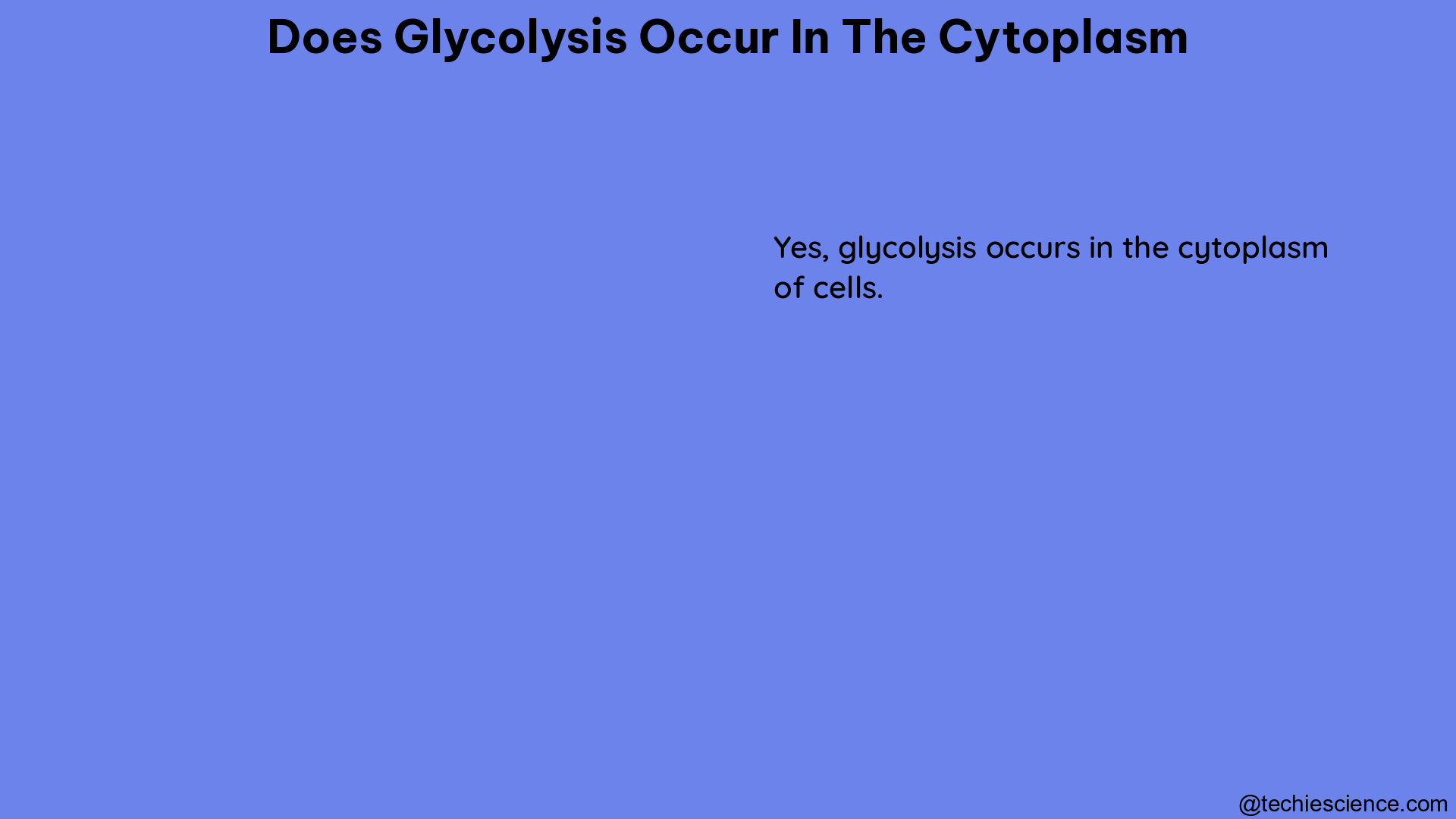Glycolysis, the fundamental metabolic process that breaks down glucose into two molecules of pyruvate while generating ATP, is a crucial component of cellular energy production. This metabolic pathway has been extensively studied, and it is well-established that glycolysis occurs in the cytoplasm of cells.
Understanding the Cytoplasm and Its Role in Glycolysis
The cytoplasm is the gel-like substance that fills the interior of a cell, excluding the nucleus and other organelles. It is the site of numerous cellular processes, including glycolysis. The cytoplasm is composed of water, dissolved ions, and a variety of macromolecules, such as proteins, lipids, and carbohydrates, which provide the necessary components and enzymes for glycolysis to take place.
The Stages of Glycolysis

Glycolysis is a multi-step process that can be divided into two main stages:
- Preparatory Phase:
- This phase involves the phosphorylation of glucose, converting it into glucose-6-phosphate.
- The enzyme hexokinase catalyzes this reaction, which occurs in the cytoplasm.
- Glucose-6-phosphate is then isomerized to fructose-6-phosphate by the enzyme phosphoglucose isomerase, also located in the cytoplasm.
-
Fructose-6-phosphate is then phosphorylated by the enzyme phosphofructokinase, producing fructose-1,6-bisphosphate, which is another cytoplasmic reaction.
-
Pay-off Phase:
- In this phase, fructose-1,6-bisphosphate is cleaved by the enzyme aldolase, producing two 3-carbon molecules: glyceraldehyde-3-phosphate and dihydroxyacetone phosphate.
- These 3-carbon molecules undergo further enzymatic reactions, including the conversion of glyceraldehyde-3-phosphate to 1,3-bisphosphoglycerate by the enzyme glyceraldehyde-3-phosphate dehydrogenase.
- The enzyme phosphoglycerate kinase then catalyzes the conversion of 1,3-bisphosphoglycerate to 3-phosphoglycerate, generating the first ATP molecules in the glycolytic pathway.
- The remaining steps in the pay-off phase, including the conversion of 3-phosphoglycerate to 2-phosphoglycerate, 2-phosphoglycerate to phosphoenolpyruvate, and phosphoenolpyruvate to pyruvate, all occur in the cytoplasm.
Quantifying Glycolytic Flux
The study published in the Journal of Biological Chemistry provides quantifiable data on the glycolytic process, specifically measuring the rate of glucose uptake and lactate excretion in cells undergoing glycolysis.
Glucose Uptake and Lactate Excretion
- Glucose uptake occurs through glucose transporters located in the cell membrane, allowing glucose to enter the cytoplasm.
- Once in the cytoplasm, glucose undergoes the glycolytic process, ultimately producing two molecules of pyruvate.
- Under aerobic conditions, pyruvate can be further metabolized in the mitochondria. However, under anaerobic conditions, pyruvate is converted to lactate, which is then excreted from the cell.
- The study found that for cells in culture, glycolytic flux can be quantified by measuring glucose uptake and lactate excretion, as these processes are directly linked to the glycolytic pathway occurring in the cytoplasm.
Measuring Glycolytic Flux
- Glucose uptake can be measured using fluorescent glucose analogs or radioactive glucose tracers, which allow researchers to track the rate of glucose entry into the cell.
- Lactate excretion can be measured using enzymatic assays or high-performance liquid chromatography (HPLC) techniques, which quantify the amount of lactate produced and released from the cell.
- By comparing the rates of glucose uptake and lactate excretion, researchers can calculate the glycolytic flux, providing a quantitative measure of the glycolytic activity occurring in the cytoplasm.
Conclusion
In summary, the available evidence from various sources, including the Mometrix Academy video, Quizlet, and the study published in the Journal of Biological Chemistry, clearly demonstrates that glycolysis, the fundamental metabolic process that breaks down glucose into pyruvate and generates ATP, occurs in the cytoplasm of cells. The cytoplasm provides the necessary environment and enzymes for the various stages of glycolysis to take place, and the quantification of glucose uptake and lactate excretion further supports the localization of glycolysis in the cytoplasmic compartment.
References:
- Mometrix Academy. (n.d.). Glycolysis. Retrieved from https://www.mometrix.com/academy/glycosis/
- Quizlet. (n.d.). Glycolysis occurs in the _. Retrieved from https://quizlet.com/explanations/questions/glycolysis-occurs-in-the-_-a-cytoplasm-b-mitochondria-c-lysosome-d-nucleus-cell-membrane-161e23eb-cdbc83c4-7a4c-4a2f-bbe7-e6a4f1b9ae3b
- Leite, T. C., Coelho, R. G., Da Silva, D., Coelho, W. S., Marinho-Carvalho, M. M., & Sola-Penna, M. (2011). Lactate downregulates the glycolytic enzymes hexokinase and phosphofructokinase in diverse tissues from mice. FEBS letters, 585(1), 92-98.
Hi, I am Sayantani Mishra, a science enthusiast trying to cope with the pace of scientific developments with a master’s degree in Biotechnology.